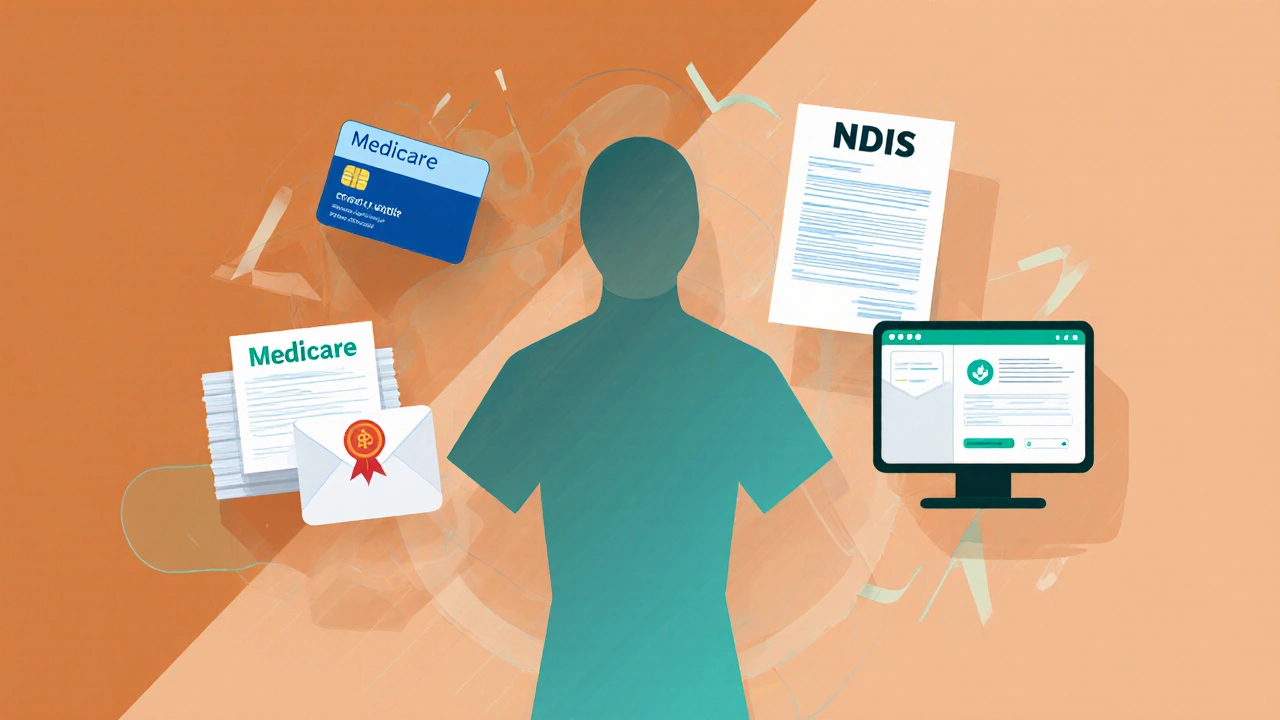Surgery Cost Planning Calculator
Your Estimated Out-of-Pocket Costs
Total Surgery Cost: $12,000
Medicare Coverage: 70-80%
Private Insurance Coverage: 70-80%
Estimated Gap: $2,400 - $4,800
Potential Government Assistance: Up to $1,200
Charity Grant Potential: Up to $2,000
Crowdfunding Potential: Up to $3,000
Final Out-of-Pocket: $0 - $1,200
Recommended Funding Options
Government Assistance
Apply for programs like NDIS or Seniors Health Card if eligible
Free MoneyCharity Grants
Research condition-specific charities for funding
Free MoneyCrowdfunding
Launch a campaign to raise funds from community
Community SupportImportant Notes
- These estimates are based on general Australian healthcare data
- Actual costs depend on your specific situation and hospital
- Always confirm with your healthcare provider and insurance company
- Consider consulting a financial advisor for complex situations
Quick Takeaways
- Identify every possible source of help before you assume surgery is out of reach.
- Government schemes and private insurers can cover up to 80% of the surgery cost for eligible patients.
- Low‑interest medical loans and payment plans are viable if you have steady income.
- Charities, community funds, and crowdfunding can bridge the remaining gap.
- Plan early, keep records, and negotiate with providers to avoid surprise bills.
When a doctor tells you you need an operation, the first reaction is often a rush of anxiety about money. You might wonder, "What if I don’t have the cash right now?" The good news is that there are more routes to funding than just paying out‑of‑pocket. Below we break down the main options, how they work, and what you should watch out for.
Surgery financing options are the collection of financial tools and programs that help patients cover the expenses associated with a medical operation. These options include insurance, government assistance, loans, charitable grants, and crowd‑sourced fundraising. Understanding each piece lets you build a customized plan that matches your situation.
1. Health Insurance - Your First Line of Defense
Health insurance is a contract with an insurer that pays for part of your medical care in exchange for regular premiums. In Australia, you’ll typically rely on a mix of Medicare and private health insurance.
Medicare (the public health system) covers most essential surgeries for Australian citizens and permanent residents, but it often leaves a "gap" payment that you must cover yourself. The gap can range from 10% to 40% of the total bill, depending on the procedure and hospital.
If you have private health insurance, it can bridge that gap by covering a larger share of the fee. Policies differ, but a typical private plan might pay 70%-80% of the scheduled fee for a scheduled operation.
Key things to check:
- Is the hospital and surgeon in your insurer’s network?
- Does your policy have a waiting period for elective surgery?
- What is the maximum out‑of‑pocket limit for the year?
2. Government Assistance Programs
Beyond Medicare, the Australian government runs several targeted assistance schemes:
- Commonwealth Seniors Health Card provides concessional fees for seniors on low incomes.
- National Disability Insurance Scheme (NDIS) can fund surgeries related to disability, subject to an approved plan.
- Veterans’ Affairs (VA) Health Service covers eligible ex‑service members and their families.
Eligibility usually hinges on income, age, or specific health conditions. Applying early-ideally before the surgeon schedules the operation-gives you time to gather required documents (tax returns, proof of residency, medical reports).
3. Medical Loans and Low‑Interest Payment Plans
When insurance and government aid still leave a shortfall, a medical loan can fill the gap. Many banks and specialised lenders offer loans with interest rates ranging from 4% to 9% APR, often with flexible repayment terms up to 5 years.
Things to consider before signing up:
- Do you have a stable income to meet monthly repayments?
- Is the loan secured (requiring collateral) or unsecured?
- What are the total interest costs over the life of the loan?
Some hospitals partner with finance companies to provide payment plans. These plans split the bill into interest‑free installments, usually for up to 12 months, but they often require a credit check.

4. Charity Funding and Community Grants
Numerous charities focus on specific medical conditions-cancer, heart disease, organ transplants, and more. These organisations may offer one‑off grants that cover part or all of a surgery.
Steps to tap into charity support:
- Identify charities linked to your diagnosis (e.g., Cancer Council Australia, Heart Foundation).
- Check their eligibility criteria-many require proof of financial hardship.
- Prepare a concise application with medical reports, a cost breakdown, and a personal statement.
Success rates vary, but the process is worth pursuing because the funds are often free-no repayment required.
5. Crowdfunding - Harnessing the Power of Community
Online platforms such as GoFundMe, Kickstarter, and local Australian site GiveNow let you share your story and ask friends, family, and even strangers for donations.
Tips for an effective campaign:
- Use a clear, compelling headline: "Help Me Get Life‑Saving Knee Surgery".
- Post regular updates with photos, surgeon notes, and progress.
- Express gratitude and show how each donation moves you closer to the goal.
Be aware that most platforms charge a 2%-5% fee, and you’ll need to handle the tax implications of any large gifts.
Comparison of Main Financing Options
| Option | Eligibility | Typical Coverage / Amount | Cost to You | Pros | Cons |
|---|---|---|---|---|---|
| Medicare (AU) | Australian citizen/permanent resident | 70‑80% of public‑hospital fee | Gap payment (10‑40%) | Low out‑of‑pocket, widely available | Limited to listed hospitals, may not cover elective procedures fully |
| Private Health Insurance | Policy holder, usually 12‑month waiting period | 70‑80% of scheduled fee | Remaining gap + premiums | More hospital choice, faster access | Premium costs, exclusions for pre‑existing conditions |
| Government Assistance (e.g., NDIS) | Low‑income, disability‑related surgery | Variable, up to full cost depending on plan | Usually none, but paperwork intensive | Free money, tailored to need | Strict eligibility, long processing time |
| Medical Loan | Credit check, steady income | Up to $50,000 (typical limit) | Interest 4‑9% APR, fees | Fast approval, flexible amount | Debt, interest adds to total cost |
| Charity Grant | Condition‑specific, financial hardship | Partial to full surgery cost | None (grant) | Free money, no repayment | Competitive, limited supply |
| Crowdfunding | Open to anyone with a story | Any amount, depends on network | Platform fees 2‑5% | Community support, quick cash | Uncertain outcome, public exposure |
6. How to Combine Options for Maximum Coverage
Most patients end up using a blend of sources. A practical workflow might look like this:
- Confirm Medicare coverage and calculate the gap.
- Check your private health policy for additional rebate.
- If the gap remains, apply for relevant government assistance (NDIS, seniors card, etc.).
- Submit a charity grant application for the remaining shortfall.
- Launch a modest crowdfunding campaign to cover any leftovers.
- As a last resort, consider a low‑interest medical loan for the final balance.
Keeping a spreadsheet of each source, expected payout date, and required documentation helps you stay organized and avoid missed deadlines.

7. Common Pitfalls and How to Avoid Them
- Waiting too long to apply. Insurance benefits and government programs often have strict timelines. Start the process as soon as the surgery is recommended.
- Ignoring the "gap" fee. Many patients assume Medicare will cover everything and later receive a surprise bill. Ask the hospital for a cost estimate that includes the gap.
- Taking high‑interest loans. Compare at least three lenders; a difference of 2% APR can add thousands over a 3‑year term.
- Over‑promising on crowdfunding. Be transparent about how funds will be used; donors appreciate honesty.
- Failing to keep records. Save every receipt, approval letter, and email-these are essential if a claim is denied or audited.
8. Real‑World Example
Sarah, a 42‑year‑old teacher from Sydney, needed arthroscopic knee surgery costing $12,000. Here's how she managed:
- Medicare covered $7,200, leaving a $4,800 gap.
- Her private health insurer added $2,400, reducing the gap to $2,400.
- She qualified for a $1,200 grant from the Australian Orthopaedic Association charity.
- Sarah opened a GoFundMe and raised $800 from friends and family.
- The remaining $400 was covered with a 0% interest 6‑month payment plan offered by the hospital.
By layering sources, Sarah avoided any out‑of‑pocket expense beyond a modest $200 co‑payment that she could afford from her savings.
Next Steps: Build Your Personal Funding Plan
Take the following actions this week:
- Ask your surgeon for a detailed, itemized cost estimate.
- Log in to your Medicare and private health portals to see exact coverage percentages.
- Download the application forms for any relevant government assistance programs.
- Identify at least one charity related to your condition and gather required documents.
- Draft a short crowdfunding story-keep it under 300 words and include a photo.
Having a clear plan reduces stress and increases the odds that you’ll get the surgery you need without a financial crisis.
Frequently Asked Questions
Can I get surgery covered if I have no private health insurance?
Yes. Medicare will cover the bulk of publicly funded procedures, but you’ll still need to pay the gap. You can reduce that gap through government assistance, charity grants, or a payment plan offered by the hospital.
How long does it take to get a charity grant?
Processing times vary. Most Australian health charities aim to decide within 2‑4 weeks after receiving a complete application. It’s wise to submit the paperwork early, as some charities have limited funding windows.
Are medical loans tax‑deductible?
Generally, personal loans are not tax‑deductible in Australia. However, if the loan is specifically for a medical expense, you may be able to claim a small portion of the interest as a medical expense deduction. Consult a tax adviser for your situation.
What documents do I need for a crowdfunding campaign?
A clear description of the surgery, a cost breakdown from the hospital, any supporting medical reports, and a photo (preferably of yourself or the condition). Adding a timeline of how the funds will be used builds trust.
Can I combine a medical loan with a payment plan?
Yes, but be careful not to over‑borrow. Use a loan only for the portion the hospital’s payment plan doesn’t cover. Keep total monthly repayments within 30% of your net income to stay financially safe.





